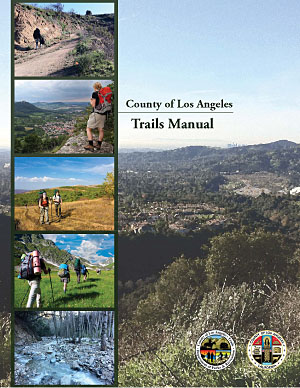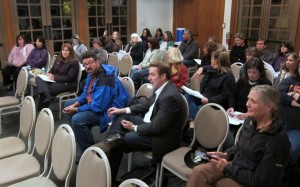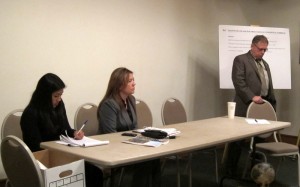 On February 28, 2011, about 50 people gathered in the beautiful Birch Room at Descanso Gardens in La Canada. We were there to review and comment upon the most recent draft of the Los Angeles County Trails Manual. But let’s back up a bit…
On February 28, 2011, about 50 people gathered in the beautiful Birch Room at Descanso Gardens in La Canada. We were there to review and comment upon the most recent draft of the Los Angeles County Trails Manual. But let’s back up a bit…
Last July, CORBA board members met with LA County Planning and Sapphos Environmental (the contractor developing the Trails Manual for the County), in a Mountain Biker only public forum. At that meeting only three CORBA board members attended, the County representatives, and nobody else. The Equestrian-only meeting had many more participants, as did the Hiker-only meeting. Since this document will not set any policy regarding trail designations, Sapphos deemed it more productive to hold separate meetings with each user group. Each group gave their input on what they’d like to see covered in the trails manual, and their special concerns.
At that time in July 2010 there was only one section of the trails manual available for review: the section concerning trail design standards. Most of the standards in that preliminary section were adapted from IMBA’s Trail Solutions book, and other reputable multi-use trail construction texts. It was to be a technical document on building and designing trails, with no influence on the contentious issues around trail user groups and trail designations.
The County’s stated policy and goal is to accommodate all user groups on all trails possible. It is a multi-use, bike-friendly policy that works. We were informed at that time that there would be another round of public hearings as the manual was developed, based on the input from user groups at these meetings. The Manual is being developed with a grant from Supervisor Antonovich’s 5th district, in which the vast majority of the County’s trails can be found. The County has never had any offical trail standards, and many of the older trails are not really sustainable by today’s standards. However, this document would NOT be applied retroactively to existing trails, but will serve as the reference for all new trails that come before the County. It is likely that many of the 88 cities in Los Angeles County will also adopt this manual for their own standards once it is ratified by the County Board of Supervisors.
Fast forward to the February 28, 2011 public hearing. Steve Messer, and CORBA member/local cycling promotor and activist Dorothy Wong attended the meeting, along with about 40 local equestrians and hikers. For a welcome change from other meetings in which CORBA has been involved, the biggest issues raised were not contentious user conflicts, but rather, design standards pertaining to potentially flawed trail designs and citations from outdated Equestrian studies and facility designs.
This is especially noteworthy. L.A. County’s multi-use goals and standards have forced user groups to work together to sort out their differences and to learn to share trails. When user group are actively sharing trails, it behooves all groups to work together. The result is a much more tolerant and mutually beneficial relationship between user groups. This is something from which the City of Los Angeles could learn a few things. This is not to say that conflicts don’t exist, but rather, that user groups are more willing to work together to solve them… because they have to.
The most vocal community representatives were Lori Paul and Marietta Kruells from the Altadena Crest Trail Restoration Working Group (ACTRWG), speaking on behalf of equestrians. CORBA Members Steve Messer and Mitch Marich have been regular participants in the ACTRWG, alongside equestrians and hikers. Their biggest concern was that the current draft of the manual cites outdated and long since refuted studies of equine contamination of streams. A biologist in the group offered up more recent studies that reflect more current research on these issues.
Steve Messer brought up a similar concern, in that the section regarding Trail Maintenance Prioritization was based on the 1998 edition of the State Parks Trails Handbook. Working with the State, we know that document is currently being revised, and fear that the County may be basing this section on outdated information. Sapphos representatives assured us that the manual will be a living document to be updated annually as new information becomes available. Messer later confirmed with the State that this section will be undergoing revision, though the revisions are relatively minor.
One glaring omission from the draft manual was any reference to or mention of providing mountain bikers a more interesting trail experience while improving safety for all users. These “traffic calming” trail features are outlined extensively in IMBA’s trail solutions book, and include recommendations for sinuosity of trails, choke points, surface texture treatments, and sight line guidelines, among other things. These features make a trail more interesting and technical for cyclists, and at the same time reduce their speed. CORBA supports measures that help avoid conflicts and improve safety. All present were in complete agreement on the need to rectify this omission from the draft manual. Sapphos affirmed they will include these additions in the next revision.
A rather humorous incident took place, when the dangers of a older design horse drinking trough were being demonstrated. It resulted a paint spill on the carpet, and an assurance that the County will seek a safer, more modern design to include in the manual.
Another major and complex concern was the designs of trailhead gates that need to exclude motorcycle and motorized vehicles, while allowing horses, hikers and bicycles. This is made even more complex by the upcoming DOJ ruling which states that all trails on non-federal lands must accomodate “other power-driven mobility devices” used by persons with a disability. This presents an extremely complex issue, as now any trail, regardless of designation, must be able to accommodate powered wheelchairs, segways, ATV’s or any other motorized device that a disabled person may want to use to access a trail. The County, and just about every jurisdiction and land manager in the country, is struggling with this complex issue. None of the equestrians, hikers or mountain bikers want to come around a corner to find an ATV, motorcycle, or even a powered wheelchair on the trail. Yet all are sensitive to the issues of accessibility and the laudable goal of providing trail access for these people. However, it is extremely impractical in most situations. The DOJ ruling is broad-reaching and in some respects vague, though it does allow land managers to make a detailed review of a trail to determine the suitability for disabled access via mobility devices. To provide access to a “powered mobility device” will make it possible for a renegade motorcyclist or ATV rider to have access to the trails just as easily as those with a disability. It may be years before this debacle is sorted out, and the County and other jurisdictions are expecting lawsuits as a result. This law goes into effect on March 15, and was only announced in the federal register a few months ago, leaving little time to prepare. The draft Manual will include a section dealing with this issue, as the County rushes to develop a policy and implementation strategy to comply with the new laws.
The manual itself is a comprehensive document that covers trail construction from concept, to planning, to design, construction, signage, and ongoing maintenance. It draws heavily on current state-of-the-art thinking in sustainable trail design, and at 188 pages in its current draft, provides ample diagrams, technical drawings and specifications. Some of those technical drawings do need further refinement, and in some cases, such as equine contamination issues, the County has been advised through these public hearings of more recent data. It is a technical document that will see marked improvements as this public feedback is incorporated. Once adopted by the Board of Supervisors, every new trail in the County must be vetted against the standards and procedures in this manual, though it does provide flexibility to accommodate differing terrain, user group ratios and other factors.
It is gratifying to work with multi-use friendly equestrians and hikers, working together to improve trail designs for all users. We look forward to the next revision of the Trails Manual, and will announce the dates of the next round of public hearings as they are scheduled.
You can learn more and read the most current draft of the document at http://lacountytrailsmanual.com
Tags: LA County, public hearing, Trails Manual







